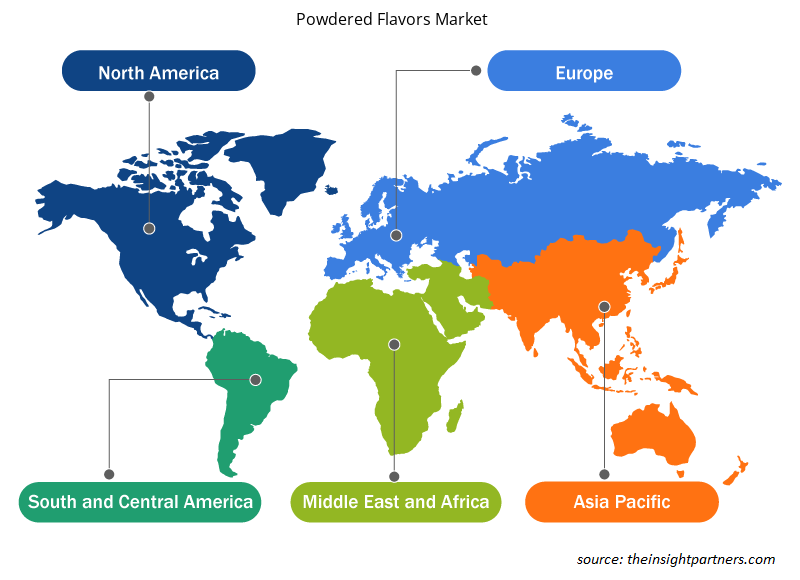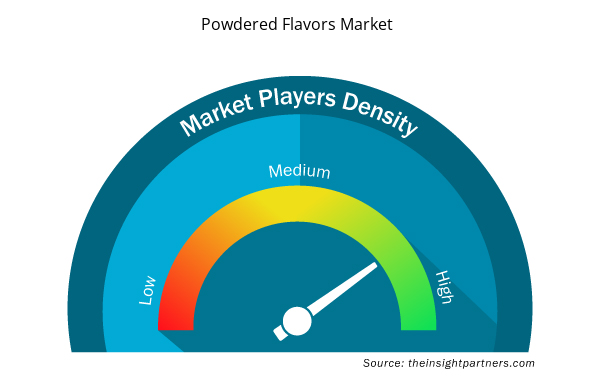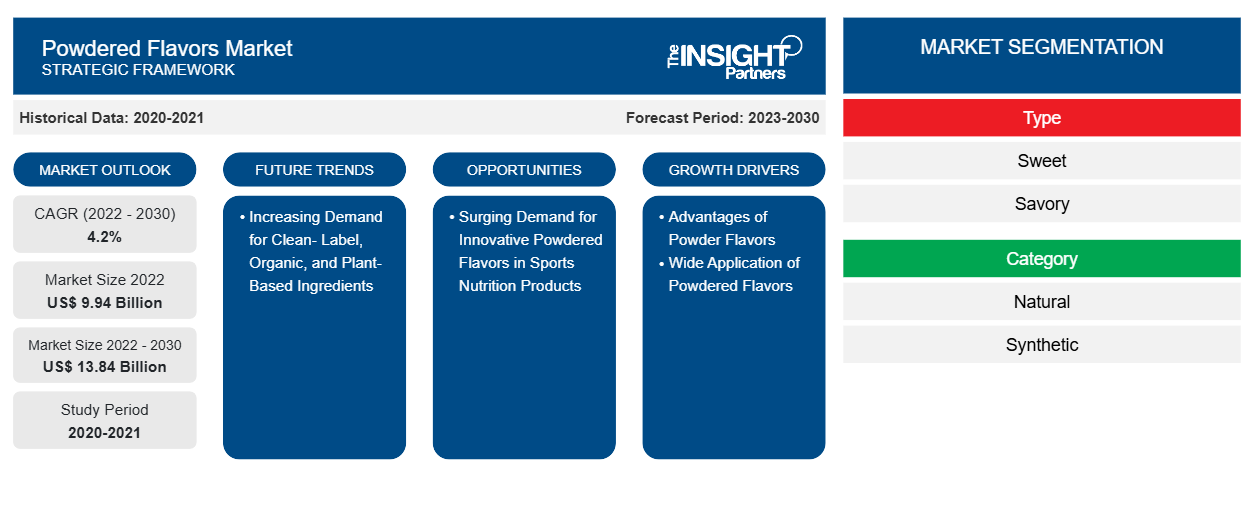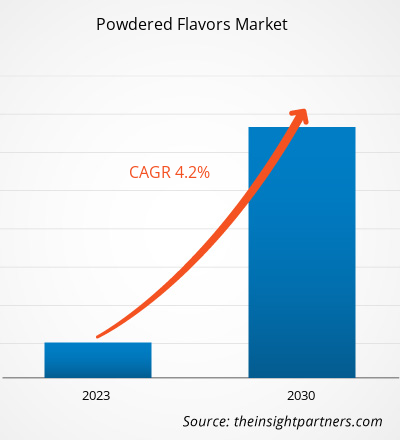[Rapporto di ricerca] Si prevede che il mercato degli aromi in polvere crescerà da 9.940,36 milioni di dollari nel 2022 a 13.841,10 milioni di dollari entro il 2030; si prevede che il mercato registrerà un CAGR del 4,2% dal 2022 al 2030.
Approfondimenti di mercato e opinioni degli analisti:
L'aroma in polvere è uno dei formati di aroma più comunemente usati dai produttori di alimenti. Gli aromi in polvere sono facilmente solubili e si amalgamano bene in diverse formulazioni, sia secche che liquide. Sono facili da trasportare e conservare, il che riduce i costi complessivi di stoccaggio e trasporto. Grazie a questi vantaggi, sono molto preferiti dai trasformatori alimentari. Gli aromi in polvere sono usati in un'ampia gamma di prodotti alimentari, tra cui prodotti da forno, dolciumi, latticini e dessert surgelati, snack salati, zuppe, salse, condimenti, pasti pronti, nutraceutici e prodotti a base di carne e sostituti della carne. La crescente domanda di prodotti alimentari biologici sta influenzando l'adozione di aromi in polvere biologici tra i produttori di alimenti, creando enormi opportunità per i fornitori di aromi biologici nel mercato degli aromi in polvere.
Fattori di crescita e sfide:
Gli aromi in polvere offrono diversi vantaggi rispetto ad altre forme, come liquidi, granuli e pasta. Gli aromi in polvere sono eccellenti esaltatori di sapore. Hanno una migliore conservabilità rispetto agli aromi in forma liquida e in pasta. Gli aromi in polvere si sciolgono e si mescolano facilmente in diverse formulazioni, sia secche che liquide. Sono facili da trasportare e conservare, riducendo i costi di stoccaggio e trasporto. A differenza degli aromi liquidi o in pasta, gli aromi in polvere sono meno vulnerabili all'ossidazione, al decadimento microbico e alle fluttuazioni di temperatura, il che aumenta il loro appeal tra i produttori di alimenti.
Gli aromi in polvere sono altamente concentrati e possono essere utilizzati in piccole quantità per ottenere i risultati desiderati. Ciò consente ai produttori di alimenti e bevande di ridurre i costi di produzione complessivi. Inoltre, gli aromi in polvere danno consistenza e sensazione al palato uniformi, rendendoli ingredienti attraenti in prodotti come snack salati, zuppe, salse, latticini, gelati e prodotti da forno. Inoltre, gli aromi in polvere sono solitamente privi di conservanti e altri componenti sintetici, il che li rende adatti per alimenti e bevande con etichetta pulita. Gli aromi liquidi e in pasta hanno una durata di conservazione più breve rispetto agli aromi in polvere. Non sono adatti per formulazioni di prodotti secchi. Pertanto, i vantaggi dei formati di aromi in polvere rispetto ai formati liquidi e in pasta stanno guidando la crescita del mercato degli aromi in polvere.
Personalizza questo report in base alle tue esigenze
Riceverai la personalizzazione gratuita di qualsiasi report, comprese parti di questo report, o analisi a livello nazionale, pacchetto dati Excel, oltre a usufruire di grandi offerte e sconti per start-up e università
- Scopri le principali tendenze di mercato in questo rapporto.Questo campione GRATUITO includerà analisi di dati che spaziano dalle tendenze di mercato alle stime e alle previsioni.
Segmentazione e ambito del report:
Il "mercato globale degli aromi in polvere" è segmentato in base a tipo, categoria, applicazione e area geografica.In base al tipo, il mercato degli aromi in polvere è segmentato in dolce, salato e altri. In base alla categoria, il mercato degli aromi in polvere è biforcato in naturale e sintetico. In base all'applicazione, il mercato degli aromi in polvere è segmentato in prodotti da forno e dolciumi; latticini e dessert surgelati; zuppe, salse e condimenti; carne e prodotti sostitutivi della carne; snack e pasti pronti; integratori alimentari e altri. Il mercato degli aromi in polvere in base alla geografia è segmentato in Nord America (Stati Uniti, Canada e Messico), Europa (Germania, Francia, Italia, Regno Unito, Russia e resto d'Europa), Asia Pacifico (Australia, Cina, Giappone, India, Corea del Sud e resto dell'Asia Pacifico), Medio Oriente e Africa (Sudafrica, Arabia Saudita, Emirati Arabi Uniti e resto di Medio Oriente e Africa) e Sud e Centro America (Brasile, Argentina e resto di Sud e Centro America).
Analisi segmentale:
In base al tipo, il mercato degli aromi in polvere è suddiviso in dolce, salato e altri. Il segmento salato detiene una quota significativa del mercato. Gli aromi salati possono essere utilizzati per prodotti come salse, zuppe, condimenti, basi alimentari e marinate, pasti pronti , carni lavorate e snack salati. L'umami, che è un gusto salato, sta crescendo in popolarità tra i consumatori e guida principalmente la crescita di questo segmento. Secondo i dati di McCormick Flavors Solutions, c'è stato un aumento del 138% degli aromi piccanti nei menu dei prodotti da forno nel 2022. L'aggiunta di peperoni come jalapeno, habanero e chipotle ai prodotti da forno ha migliorato l'esperienza del sapore. Inoltre, si prevede che la tendenza crescente al consumo di snack speziati aumenterà la domanda di aromi salati. Si prevede che questi fattori guideranno la crescita del segmento nel mercato globale degli aromi in polvere.
Analisi regionale:
In base alla geografia, il mercato degli aromi in polvere è suddiviso in cinque regioni chiave: Nord America, Europa, Asia Pacifico, Sud e Centro America e Medio Oriente e Africa. Il mercato globale degli aromi in polvere è stato dominato dall'Asia Pacifico; il mercato in questa regione è stato valutato a 3.178,93 milioni di dollari nel 2022. Il Nord America è il secondo maggiore contributore al mercato, che detiene quasi il 27% della quota di mercato globale degli aromi in polvere. Si prevede che il Sud e Centro America registreranno un CAGR del 5,8% nel mercato degli aromi in polvere nel periodo 2022-2030. Il Nord America è una delle regioni significative del mercato degli aromi in polvere a causa della presenza di un'industria alimentare e delle bevande consolidata, della crescente domanda di cibi pronti e della crescente domanda di aromi in polvere in vari prodotti come prodotti da forno e dolciumi, snack salati, prodotti a base di carne e sostituti della carne, zuppe, salse, pasti pronti e latticini e dessert surgelati. L'industria alimentare e delle bevande del Nord America sta crescendo rapidamente a causa dell'aumento della popolazione e dello stile di vita frenetico, che porta a un aumento del consumo di alimenti e bevande confezionati. Inoltre, l'aumento della popolazione femminile lavoratrice nella regione e il crescente numero di famiglie con doppio reddito stanno guidando la domanda di cibi pronti. Secondo l'Economic Research Service (USDA ERS) del Dipartimento dell'agricoltura degli Stati Uniti, la spesa per alimenti e bevande nei negozi al dettaglio e per pasti e spuntini fuori casa ha rappresentato 2,12 trilioni di dollari nel 2021. La crescita delle vendite al dettaglio di alimenti e bevande sta fornendo un forte potenziale di crescita per il mercato degli additivi alimentari, incluso il mercato degli aromi in polvere.
Sviluppi del settore e opportunità future:
Di seguito sono elencate le varie iniziative intraprese dai principali attori che operano nel mercato degli aromi in polvere:
- Nel 2022, Symrise ha annunciato una gamma di ingredienti naturali a base di mirtilli per applicazioni alimentari, di bevande e per la salute dei consumatori.
- Nel 2020, Flavorchem ha annunciato l'apertura dell'SRS Center for Taste Innovation presso il suo campus di Downers Grove.
- Nel 2020, Gold Coast Ingredients Inc ha lanciato il gusto vegano di gouda affumicato.
- Nel 2020, Fona International Inc ha presentato TrueTaste, la sua ultima tecnologia brevettata per l'aroma.
Impatto del COVID-19:
La pandemia di COVID-19 ha colpito quasi tutti i settori in vari paesi. I lockdown, le restrizioni di viaggio e le chiusure aziendali in Nord America, Europa, Asia Pacifico (APAC), Sud e Centro America (SAM) e Medio Oriente e Africa (MEA) hanno ostacolato la crescita di diversi settori, tra cui l'industria alimentare e delle bevande. La chiusura delle unità produttive ha disturbato le catene di fornitura globali, le attività di produzione, i programmi di consegna e le vendite di prodotti essenziali e non essenziali. Diverse aziende hanno assistito a ritardi nelle consegne dei prodotti e a un crollo delle vendite dei loro prodotti nel 2020.
Durante la fase iniziale della pandemia, l'industria alimentare e delle bevande nella regione ha dovuto affrontare un declino dovuto alla chiusura delle unità produttive e all'interruzione della catena di fornitura. La pandemia ha interrotto le attività produttive con restrizioni imposte dalle autorità governative in paesi globali come Stati Uniti, Canada, Germania, Regno Unito, India e Cina. Ciò ha creato una carenza di materie prime, con conseguente divario tra domanda e offerta. Anche il mercato degli aromi in polvere ha assistito a impatti simili della pandemia. Poiché la pandemia ha interrotto le catene di fornitura globali, l'approvvigionamento di materie prime è stato difficile. Inoltre, le piccole e medie imprese con bassi livelli di inventario hanno assistito a un calo delle vendite che ha avuto un impatto negativo sulla loro redditività. Tuttavia, la pandemia ha alterato le preferenze dei consumatori globali poiché la salute è diventata la massima priorità. La preferenza per ingredienti completamente naturali, biologici e privi di OGM è aumentata poiché i consumatori hanno percepito questi prodotti come più sani di quelli convenzionali. Inoltre, l'attenzione alla salute immunitaria è aumentata drasticamente, il che dovrebbe offrire opportunità redditizie per aromi che rafforzano il sistema immunitario come curcuma in polvere, zenzero in polvere e cannella.
Nel 2021, diverse economie hanno ripreso le operazioni poiché diversi governi hanno annunciato un allentamento delle restrizioni imposte in precedenza, il che ha avuto un impatto positivo sul mercato globale. Inoltre, ai produttori è stato consentito di operare a piena capacità, il che li ha aiutati a superare il divario tra domanda e offerta.
Approfondimenti regionali sul mercato degli aromi in polvere
Le tendenze regionali e i fattori che influenzano il Powdered Flavors Market durante il periodo di previsione sono stati ampiamente spiegati dagli analisti di Insight Partners. Questa sezione discute anche i segmenti e la geografia del Powdered Flavors Market in Nord America, Europa, Asia Pacifico, Medio Oriente e Africa, e Sud e Centro America.

- Ottieni i dati specifici regionali per il mercato degli aromi in polvere
Ambito del rapporto di mercato sugli aromi in polvere
| Attributo del report | Dettagli |
|---|---|
| Dimensioni del mercato nel 2022 | 9,94 miliardi di dollari USA |
| Dimensioni del mercato entro il 2030 | 13,84 miliardi di dollari USA |
| CAGR globale (2022-2030) | 4,2% |
| Dati storici | 2020-2021 |
| Periodo di previsione | 2023-2030 |
| Segmenti coperti | Per tipo
|
| Regioni e Paesi coperti | America del Nord
|
| Leader di mercato e profili aziendali chiave |
|
Densità dei player del mercato degli aromi in polvere: comprendere il suo impatto sulle dinamiche aziendali
Il mercato degli aromi in polvere sta crescendo rapidamente, spinto dalla crescente domanda degli utenti finali dovuta a fattori quali l'evoluzione delle preferenze dei consumatori, i progressi tecnologici e una maggiore consapevolezza dei benefici del prodotto. Con l'aumento della domanda, le aziende stanno ampliando la propria offerta, innovando per soddisfare le esigenze dei consumatori e capitalizzando sulle tendenze emergenti, il che alimenta ulteriormente la crescita del mercato.
La densità degli operatori di mercato si riferisce alla distribuzione di aziende o società che operano in un particolare mercato o settore. Indica quanti concorrenti (operatori di mercato) sono presenti in un dato spazio di mercato in relazione alle sue dimensioni o al valore di mercato totale.
Le principali aziende che operano nel mercato degli aromi in polvere sono:
- Aromi e fragranze di campane
- Ingredienti della Gold Coast Inc.
- Sapori rinascimentali
- Flavorcan International Inc
- Sapori del Pacifico blu
Disclaimer : le aziende elencate sopra non sono classificate secondo un ordine particolare.

- Ottieni una panoramica dei principali attori del mercato degli aromi in polvere
Scenario competitivo e aziende chiave:
Alcuni dei principali attori che operano nel mercato globale degli aromi in polvere sono Bell Flavors & Fragrances, Gold Coast Ingredients Inc, Renaissance Flavors, Flavorcan International Inc, Blue Pacific Flavors, CUSTOM FLAVORS, Flavorchem & Orchidia Fragrances, Symrise, Synergy, FONA International Inc e Robertet Group. Questi attori del mercato stanno adottando iniziative di sviluppo strategico per espandersi, guidando ulteriormente la crescita del mercato degli aromi in polvere.
- Analisi storica (2 anni), anno base, previsione (7 anni) con CAGR
- Analisi PEST e SWOT
- Valore/volume delle dimensioni del mercato - Globale, regionale, nazionale
- Industria e panorama competitivo
- Set di dati Excel



Report Coverage
Revenue forecast, Company Analysis, Industry landscape, Growth factors, and Trends

Segment Covered
This text is related
to segments covered.

Regional Scope
North America, Europe, Asia Pacific, Middle East & Africa, South & Central America

Country Scope
This text is related
to country scope.
Domande frequenti
Advantages of powdered flavors and wide application scope are the key factors driving the global powdered flavors market growth.
South & Central America is estimated to register the fastest CAGR in the global powdered flavors market over the forecast period. Fruity and natural flavors have become more prevalent in food industries across the region due to their different taste, fragrance, and health benefits. The region's ongoing "natural is better" trend further boosts the demand for natural and organic-sourced powdered flavors.
Bell Flavors & Fragrances, Gold Coast Ingredients Inc, Renaissance Flavors, Flavorcan International Inc, Blue Pacific Flavors, CUSTOM FLAVORS, Flavorchem & Orchidia Fragrances, Symrise, Synergy, FONA International Inc are a few players operating in the global powdered flavors market.
Based on category, the natural segment is estimated to register the fastest CAGR in the global powdered flavors market over the forecast period. Natural flavors are produced from animal or plant origin, through physical, microbiological, or enzymatic processes. The use of natural flavors has been rising among the food processors, as they provide desirable sensory characteristics, along with contributing to the healthiness of the product.
Based on type, the savory segment held the largest share in the global powdered flavors market in 2022. Savory flavors can be used for products such as sauces, soups, dressings, food bases and marinades, ready-to-eat meals, processed meats, and savory snacks. Umami which is a savory taste is growing in popularity among the consumers and majorly drives the growth of this segment
In 2022, Asia Pacific held the largest share of the global powdered flavors market. The rapid development of the food & beverage industry in Asia Pacific has boosted the demand for various flavors. Powdered flavors are extensively applied in food and beverage products to enhance flavor. This has prompted manufacturers to create new flavored products and upgrade product flavors.
Trends and growth analysis reports related to Food and Beverages : READ MORE..
The List of Companies - Powdered Flavors Market
- Bell Flavors & Fragrances
- Gold Coast Ingredients Inc
- Renaissance Flavors
- Flavorcan International Inc
- Blue Pacific Flavors
- CUSTOM FLAVORS
- Flavorchem & Orchidia Fragrances
- Symrise
- Synergy
- FONA International Inc
The Insight Partners performs research in 4 major stages: Data Collection & Secondary Research, Primary Research, Data Analysis and Data Triangulation & Final Review.
- Data Collection and Secondary Research:
As a market research and consulting firm operating from a decade, we have published and advised several client across the globe. First step for any study will start with an assessment of currently available data and insights from existing reports. Further, historical and current market information is collected from Investor Presentations, Annual Reports, SEC Filings, etc., and other information related to company’s performance and market positioning are gathered from Paid Databases (Factiva, Hoovers, and Reuters) and various other publications available in public domain.
Several associations trade associates, technical forums, institutes, societies and organization are accessed to gain technical as well as market related insights through their publications such as research papers, blogs and press releases related to the studies are referred to get cues about the market. Further, white papers, journals, magazines, and other news articles published in last 3 years are scrutinized and analyzed to understand the current market trends.
- Primary Research:
The primarily interview analysis comprise of data obtained from industry participants interview and answers to survey questions gathered by in-house primary team.
For primary research, interviews are conducted with industry experts/CEOs/Marketing Managers/VPs/Subject Matter Experts from both demand and supply side to get a 360-degree view of the market. The primary team conducts several interviews based on the complexity of the markets to understand the various market trends and dynamics which makes research more credible and precise.
A typical research interview fulfils the following functions:
- Provides first-hand information on the market size, market trends, growth trends, competitive landscape, and outlook
- Validates and strengthens in-house secondary research findings
- Develops the analysis team’s expertise and market understanding
Primary research involves email interactions and telephone interviews for each market, category, segment, and sub-segment across geographies. The participants who typically take part in such a process include, but are not limited to:
- Industry participants: VPs, business development managers, market intelligence managers and national sales managers
- Outside experts: Valuation experts, research analysts and key opinion leaders specializing in the electronics and semiconductor industry.
Below is the breakup of our primary respondents by company, designation, and region:

Once we receive the confirmation from primary research sources or primary respondents, we finalize the base year market estimation and forecast the data as per the macroeconomic and microeconomic factors assessed during data collection.
- Data Analysis:
Once data is validated through both secondary as well as primary respondents, we finalize the market estimations by hypothesis formulation and factor analysis at regional and country level.
- Macro-Economic Factor Analysis:
We analyse macroeconomic indicators such the gross domestic product (GDP), increase in the demand for goods and services across industries, technological advancement, regional economic growth, governmental policies, the influence of COVID-19, PEST analysis, and other aspects. This analysis aids in setting benchmarks for various nations/regions and approximating market splits. Additionally, the general trend of the aforementioned components aid in determining the market's development possibilities.
- Country Level Data:
Various factors that are especially aligned to the country are taken into account to determine the market size for a certain area and country, including the presence of vendors, such as headquarters and offices, the country's GDP, demand patterns, and industry growth. To comprehend the market dynamics for the nation, a number of growth variables, inhibitors, application areas, and current market trends are researched. The aforementioned elements aid in determining the country's overall market's growth potential.
- Company Profile:
The “Table of Contents” is formulated by listing and analyzing more than 25 - 30 companies operating in the market ecosystem across geographies. However, we profile only 10 companies as a standard practice in our syndicate reports. These 10 companies comprise leading, emerging, and regional players. Nonetheless, our analysis is not restricted to the 10 listed companies, we also analyze other companies present in the market to develop a holistic view and understand the prevailing trends. The “Company Profiles” section in the report covers key facts, business description, products & services, financial information, SWOT analysis, and key developments. The financial information presented is extracted from the annual reports and official documents of the publicly listed companies. Upon collecting the information for the sections of respective companies, we verify them via various primary sources and then compile the data in respective company profiles. The company level information helps us in deriving the base number as well as in forecasting the market size.
- Developing Base Number:
Aggregation of sales statistics (2020-2022) and macro-economic factor, and other secondary and primary research insights are utilized to arrive at base number and related market shares for 2022. The data gaps are identified in this step and relevant market data is analyzed, collected from paid primary interviews or databases. On finalizing the base year market size, forecasts are developed on the basis of macro-economic, industry and market growth factors and company level analysis.
- Data Triangulation and Final Review:
The market findings and base year market size calculations are validated from supply as well as demand side. Demand side validations are based on macro-economic factor analysis and benchmarks for respective regions and countries. In case of supply side validations, revenues of major companies are estimated (in case not available) based on industry benchmark, approximate number of employees, product portfolio, and primary interviews revenues are gathered. Further revenue from target product/service segment is assessed to avoid overshooting of market statistics. In case of heavy deviations between supply and demand side values, all thes steps are repeated to achieve synchronization.
We follow an iterative model, wherein we share our research findings with Subject Matter Experts (SME’s) and Key Opinion Leaders (KOLs) until consensus view of the market is not formulated – this model negates any drastic deviation in the opinions of experts. Only validated and universally acceptable research findings are quoted in our reports.
We have important check points that we use to validate our research findings – which we call – data triangulation, where we validate the information, we generate from secondary sources with primary interviews and then we re-validate with our internal data bases and Subject matter experts. This comprehensive model enables us to deliver high quality, reliable data in shortest possible time.


 Ottieni un campione gratuito per questo repot
Ottieni un campione gratuito per questo repot